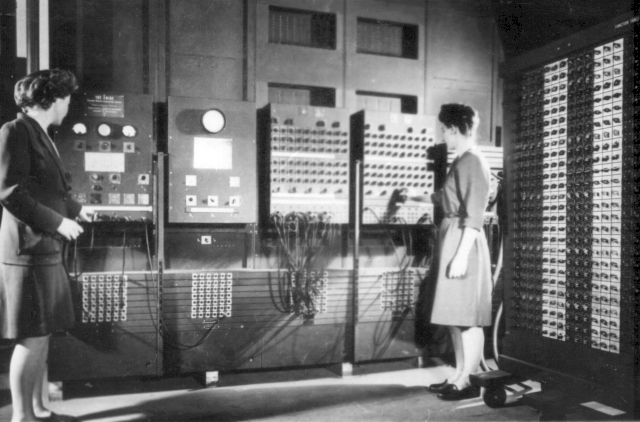The technological advances that occurred during the first half of the 20th century accelerated the birth of computing. Starting from the bases of Babbage’s machine, having experience in the use of desktop calculators, adding later materials from telephone technology and with the US Army’s needs (they wanted to produce new artillery weapons during WWII), the only element missing to move towards the creation of computers as we know them today was electronics.
In this context, at the University of Pennsylvania, the physicist John W. Mauchly and the electronic engineer John Presper Eckert developed the project of a machine that would be contracted by the Ballistic Research Labs (BRL) due to their computing needs. The BRL had hired various calculation tools, but this one proved to be the fastest, so they invested up to $400,000 to finish developing it. This is how the ENIAC (Electronic Numerical Integrator and Computer) was born and became the first general purpose digital electronic computer.
The ENIAC was built secretly during the war and evolved from the initial project, a machine that had to solve ballistic calculations, to a universal machine that would be able to automatically execute many other routine tasks. It was publicly launched in 1946 once the war was over: it had 18,000 electronic tubes, weighed 30 tons, occupied an area of 167 m² and consumed a lot of electrical energy. The ENIAC was still decimal and relatively modest in terms of its memory, but it was nevertheless able to perform calculations much faster than any of the machines that had preceded it; it could perform 5,000 sums per second and did in just one hour the work that all the women who had worked for the BRL could do in two months. Now that the war was finally over, the computer began to be used in the scientific field for research purposes.
The invention of the ENIAC was a starting point for the development of the first generation of digital computers. The machine demonstrated the feasibility of electronic computing and was the basis for many other later projects. In 1947, when the ENIAC had been in operation for a year, the ACM was founded. It was a professional organization created to face the emergence of a new profession and share ideas about the applications of digital computers and how they should face IBM if it took control of the profession. Indeed, at the same time that the tabulator company was moving on to commercialize electronic calculators, it also tried to react against the popularity of the ENIAC with a machine called the SSEC (Selective Sequence Electronic Calculator), which did not reach the height of the first but was one of the reasons why Moore’s faculty prevent Mauchly and Eckert from patenting the ENIAC as their own invention. Thus, they left the school and started commercializing and patenting their own ideas. The ENIAC project was gradually left behind and the machine stopped working in 1955.
The commercialization of the first computers
Throughout the following years Mauchly and Eckert worked on several projects that started from the bases of their first machine. Some of these projects were never finished, while others, such as the BINAC, a binary computer that was the first with dual CPUs, were key and served to test the construction and programming. The second project of the two technicians was the UNIVAC, the first computer sold commercially. It no longer responded only to calculation needs, nor to a restricted use for the military and scientific fields, but was also intended for administration, a field that until then had been headed by tabulators.
Although IBM had the opportunity to fund UNIVAC when its main patron died in an accident, Thomas Watson rejected Mauchly and Eckert’s proposal because he did not believe (no one did at the time) that computers would have commercial potential, even if they were revolutionary, since he thought only a few copies would have to be made. However, beyond being used in the US census offices, in 1954 the UNIVAC was installed for the first time in a private company and, shortly after, there were already about ten companies (among them IBM) which began to market different machines following their example.
The first generation of computers, based on electron tubes like those used by the ENIAC, is made up of all these machines that were developed roughly between 1946 and 1956, when computing introduced the transistor, which had discovered in 1948, a technological advance that increased their computing power and led to the commercialization of second-generation computers.

